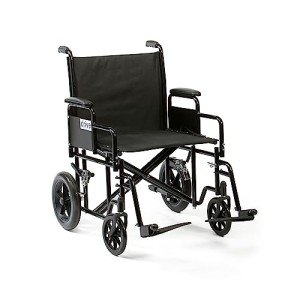Seven Reasons To Explain Why Bariatric Wheelchair 24 Inch Seat Is Important

Bariatric Wheelchair Seat Width
Seat Width
Having the right seat width is crucial to wheelchair users who spend longer periods in their chairs. Too narrow a seat will trigger pressure on the hips and thighs which could result in sores or pressure points. Having too large a seat can also make it difficult for the user to reach the hand rims to propel themselves or maneuver in small spaces.
To measure the right seat width an individual would sit on a chair normally and have their measurement taken across their lap at the largest point which is normally their hips. A wheelchair measuring tape can be utilized to measure this, however a yard stick is preferred as it prevents individuals from covering the tape around their hips which would provide an incorrect result.
The standard wheelchair seat width is 16" (narrow grownup), 18" (basic adult), and 20" (large grownup). For bariatric clients, a 24" seat is available. This heavy-duty additional large bariatric wheelchair from Medline features swing-away footrests, a carbon steel frame with rust- and chip-resistant chrome plating, and easy-to-clean vinyl upholstery. It has a weight capacity of 500 pounds.
Seat Depth
Traditionally, the seat depth of a bariatric wheelchair was included 2" to the measurement taken at the user's largest point (normally their hips). This was suggested to accommodate extra layers of clothing that may be worn throughout cold weather condition. Nevertheless, this practice is ending up being less typical as wheelchair users are able to spend more time inside your home and are not wearing long coats. This makes the seat depth of a chair less essential when selecting a bariatric wheelchair. However, it is still crucial to pick an option that provides adequate assistance for bigger users.

The Medline folding additional large bariatric manual wheelchair includes a comfy 24" seat width and a heavy-duty slide tube silver vein frame. It likewise has an adjustable axle and tool-free elevating legrests.
Seat Height
When it concerns determining the right wheelchair seat width you need to always measure from the user's largest point which is usually their hips. You will also need to think about whether the user is going to be wearing a winter coat as this may include 2" to the width needed.
When a wheelchair remains in usage it must only be run on level surfaces with the wheel locks completely engaged. This is to avoid the chair from having the ability to move slopes that are 10 degrees or greater. It is likewise important to remember that any activity that may shift the center of mass in the chair ought to be made with care. This consists of grabbing products that need the person to lean out of their seat or trying to stand up from it.
Whenever you have the chair in usage it is suggested that you routinely examine it for damage and lubricate any areas that are deemed required. For instance, the casters ought to be lubed by removing the caster fork and using a multi-purpose grease to apply to the caster stem bearings. Likewise, the foot plates can be changed by loosening the bolt and then moving them to the wanted position. This enables the feet to sit comfortably on the footplate and prevents any pressure points from forming. This can be very uneasy for the user and if left ignored, can cause press sores.
Weight Capacity
Bariatric wheelchairs are created to support more weight than basic wheelchairs. This makes them stronger and much better geared up to handle falls. They are also generally bigger and wider, making them less maneuverable in tight spaces than standard wheelchairs. They need vehicles with unique ramps and lifts to fill them, along with drivers who understand how to best transport them from one area to the next.
When picking a wheelchair, consider its weight capacity as it will be the main determining aspect in whether it will accommodate your traveler's needs. buy bariatric wheelchair of the chair is often noted as a static load, indicating that it suggests the amount of weight the chair can easily hold while standing still. Nevertheless, some makers likewise note an active load that is based upon a drop test and can replicate the impact of someone sitting down in the chair. This may be a more reputable measurement of the weight limit, depending upon your needs.
If you plan to perform activities that move your center of gravity in the seat (such as grabbing items), be sure to have front casters pointed in a forward instructions and wheel locks engaged so the chair will not tip over. Also, inspect that casters are lubricated frequently to prevent excessive wear and abrasions. The lubrication treatment involves removing the fork, separating the caster from the wheel, and greasing the caster stem bearings with high-quality multi-purpose grease.
